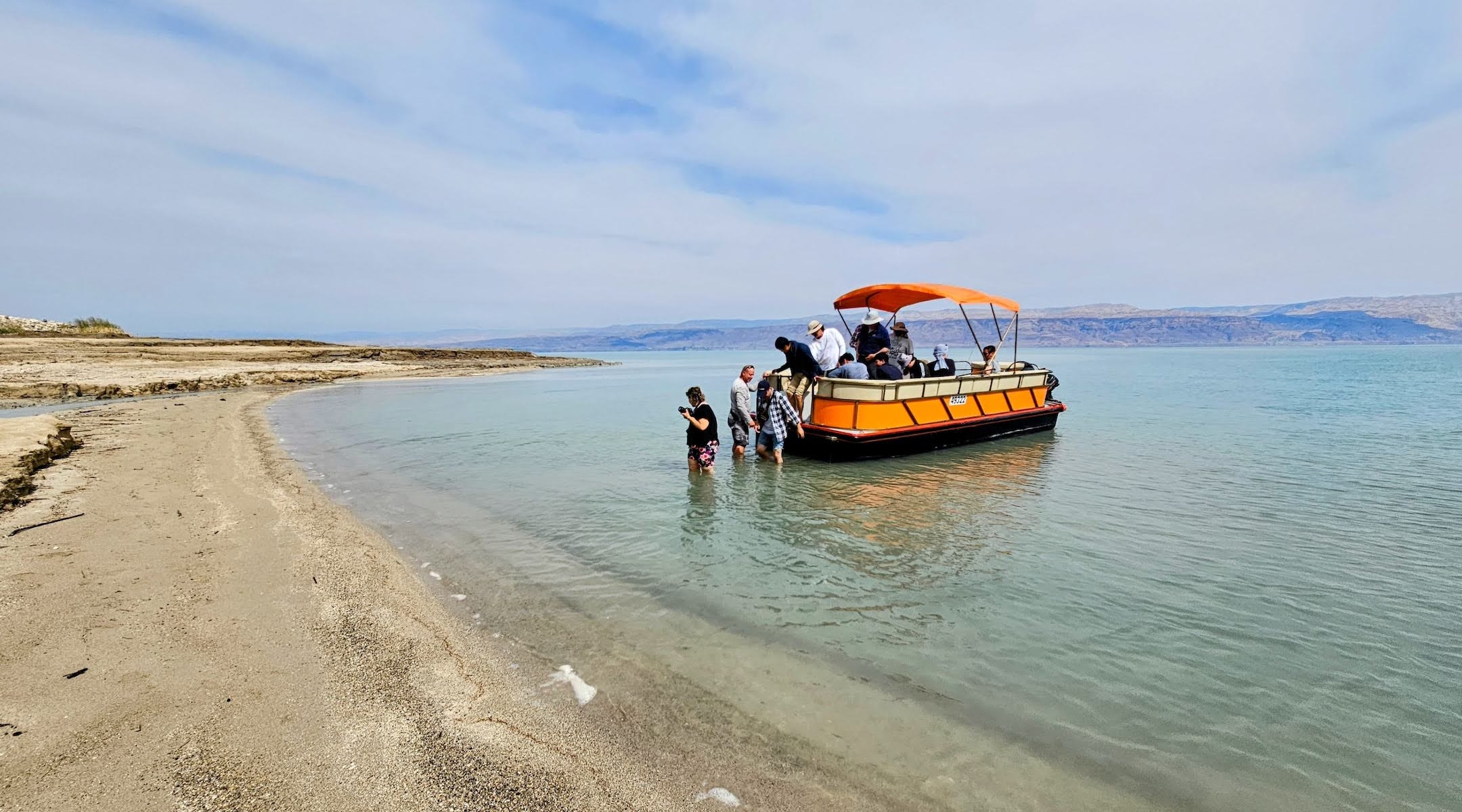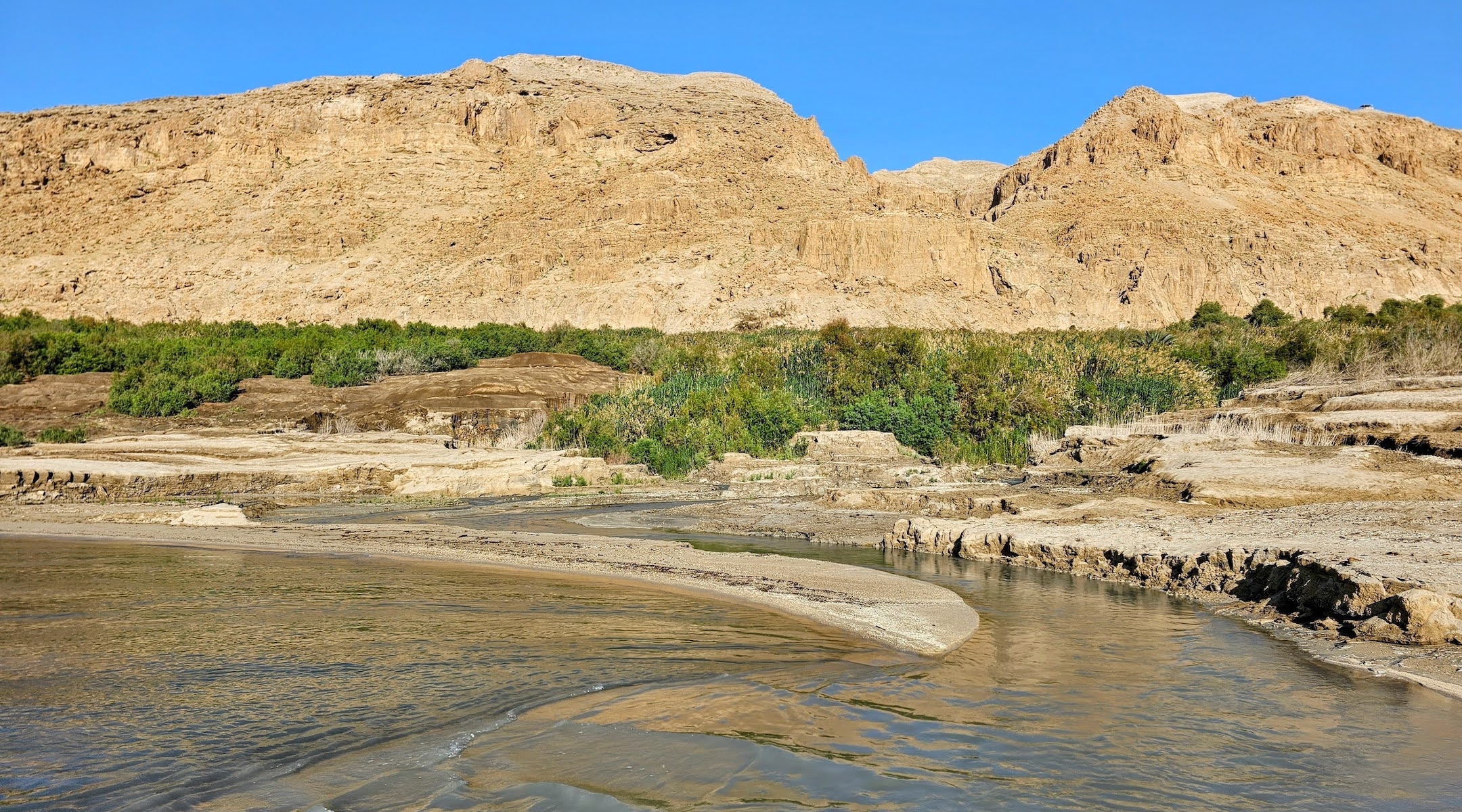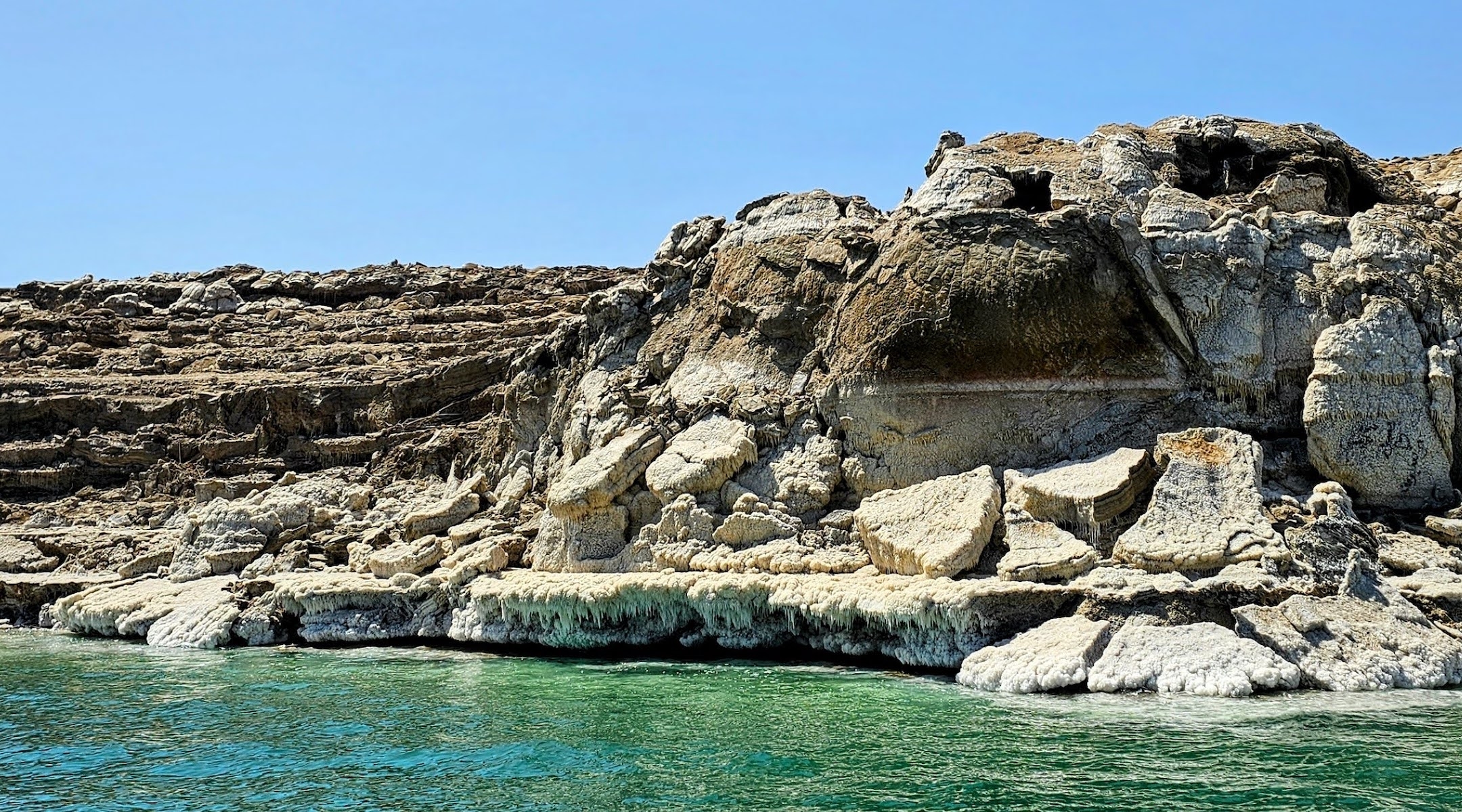A boat trip aimed at saving the Dead Sea also explores the marvels revealed by its evaporation
Noam Bedein is the latest activist to confront a problem that has bedeviled Israel — how to save an ecological marvel and tourist attraction that is being depleted by water scarcity, industry and climate change

Passengers wade into the waters of the Dead Sea from Noam Bedein’s boat on a recent excursion. (Noam Bedein)
DEAD SEA, Israel (JTA) — As the owner of the second boat to sail the Dead Sea in the past 75 years, Noam Bedein knows its salty waters better than almost anyone. But lately, his excursions have led him to discover sites neither he nor anyone else has ever seen.
A few days before World Water Day in late March, Bedein came upon a bubbling brook feeding into the sea, which he named the Jerusalem River. The stream, the animals surrounding it and the beach it flows through were submerged underwater as recently as the mid-2000s. Bedein and his partner, Ari Fruchter, believe they are the first people ever to set foot there.
It’s an experience Bedein keeps having, and for him, it’s a paradoxical one: His mission is to save the Dead Sea. But as it dries up, it reveals new wonders to him.
“Out of the devastation, life finds a way,” Bedein told the Jewish Telegraphic Agency during one of his boat’s first excursions.
Bedein is the latest activist to confront a problem that has bedeviled Israel — how to save this ecological marvel and tourist attraction that is being depleted by water scarcity, industry and climate change. Bedein’s approach with his and Fruchter’s nonprofit, the Dead Sea Revival Project, is to raise awareness about the disappearing Dead Sea by bringing people to see it for themselves.
Bedein’s immersive boat tours provide visitors “with an intimate encounter that fosters deep connection and understanding” about the Dead Sea, he told JTA.
The odds of saving the Dead Sea are steep. Bordered by Israel and the West Bank on the west and Jordan on the east, it is the deepest point on earth, has almost 10 times as much salinity as the ocean and is renowned for its therapeutic mud. In 2019, according to records from the Israeli Tourism Ministry, it was the country’s third-most visited site, after Jerusalem and Tel Aviv, drawing a million tourists per year, reported Israeli business publication The Marker.
The Dead Sea is also an economic engine for Israel — something that, ironically, is a threat to the sea’s continued existence. A market research report published last year found that the Dead Sea mud cosmetics market is slated to be worth $2.6 billion by 2031. The chemical factories producing the cosmetics, which extract potash and bromine from the area, are found in both Israel and Jordan, and pump some 61.3 billion gallons of seawater per year in total as of 2018, according to NBC.
That extraction, plus a reduction in the inflow of water from the Jordan River, has led the Dead Sea to dry up in recent decades. A 2022 Israeli government report said that since 1980, the sea has lost some 40% of its volume and is retreating by more than three feet per year. According to Bedein, the Dead Sea’s water loss amounts to as much as 600 Olympic pools every day.
The southern basin of the Dead Sea, which is called Ein Bokek and is lined with hotels, has been disconnected from the northern part. Today, the “sea” at Ein Bokek is actually comprised of 12 foot-deep evaporation pools that are entirely artificial. According to Bedein, most tourists at the hotels are entirely unaware that they are not actually at the Dead Sea.
“However you look at it, there isn’t a magic pill to fix this, and that’s the reason nothing’s been done so far,” Nadav Lensky, head of the Dead Sea Observatory at the Geological Survey of Israel, told JTA. “Every solution that is put forward comes with problems of its own.”

Hailing from the West Bank settlement of Tekoa, Bedein, 41, worked in Israel advocacy in the Gaza border town of Sderot before shifting his focus to the Dead Sea. He is an environmental photojournalist by training who has now trained his lens on this body of water, hoping to show people what it actually looks like — and the ecological damage that is caused — when a large saltwater lake disappears.
To do that, he convinced the Israeli government to allow him to sail a boat on the Dead Sea, a quest that involved more than a year of overcoming bureaucratic hurdles. It is only the second boat to take to the water since Israel’s 1948 War of Independence. The boat, which holds up to 13 passengers, makes up to three trips a day, three times a week, but as of September, its operations will be expanded to five days a week. In total, Bedein says he has hosted between 400 and 500 people on private excursions.
Bedein is acutely aware that the end goal of saving the Dead Sea is “way above my personal shoulders,” but, he said, that knowledge does not detract from his mission.
“The journey is fascinating and motivating for me,” he said.
The boat’s two-hour journey is filled with wonders. On a recent outing, the blinding white salt formations look like glaciers or penitentes, and clash with the backdrop of the Judean Desert’s brutal reddish rock. Graduated terraces hewn out of the cliff look manmade, but each three foot-high step represents another summer in which the waters of the Dead Sea have evaporated.
A salt cavern perched on a rock several meters above sea level elicits a gasp from Bedein. He has not been to the area in at least three years. Rifling through a wad of photographs, Bedein shows the passengers on the boat a photo of the same cavern from 2016, its mouth at sea level. He snaps a shot of the newly elevated cavern. The side-by-side images are currently on display as part of a timelapse photo exhibition marking this year’s Earth Day at the Cultural Center in Arad, a city 17 miles west of the Dead Sea.
“You can feel the density of the water lugging at the boat and the bitter, sticky spray on your face and lips,” said Naomi Verber, who was on board with her baby. “The salt rock formations are otherworldly, like seeing the transition between sea and land in suspended animation.”
(Bedein claimed that Verber’s child was “the first infant to sail the Dead Sea in at least 100 years.” Whether that is true is unclear. Orit Engelberg-Baram, an environmental historian who wrote her doctoral dissertation on the Dead Sea, told JTA that a baby may well have sailed its waters during the evacuation of Kibbutz Beit HaArava, located in what is now the West Bank, during Israel’s War of Independence in 1948.)

Fruchter, meanwhile, is spearheading an effort to promote awareness about the ecological crisis of the Dead Sea by raising money to build the Dead Sea Museum of Art on a five-and-a-half-acre parcel of land in Arad. The museum, which hopes to attract half a million tourists a year once it is constructed, will combine exhibits on climate tech innovation and multimedia art installations in a carbon neutral building to both educate people about the sea and, in a grim but possible future, memorialize it.
While the industrial activity surrounding the sea often gets blamed for its depletion, Bedein says it isn’t the main culprit. He estimates that the chemical plants contribute to 30% of the problem, while the other 70% is due to the reduction of the source of the water in the Jordan River.
According to Lensky, 60 years ago, a billion cubic meters of water flowed from the Jordan River into the Dead Sea. Today, less than 10% of that amount reaches it, partly because of the construction of dams around the Yarmouk River — which flows between Israel, Jordan and Syria — and partly because Jordan, one of the driest countries in the world, cannot afford to both provide water to its population and regenerate the Dead Sea. Jordan, Syria and Israel all draw water from the Sea of Galilee basin that would otherwise be flowing into the Dead Sea.
The chemical plants, Bedein said, also draw attention to the Dead Sea, which he sees as a positive.
“It’s not about how much water is being pumped out of the Dead Sea, it’s about how much water is coming in,” he said. “It’s very reductive to blame the factories. If you close down all the factories tomorrow, there goes the entire industry in Ein Bokek, and you will have reduced awareness even more.”
The key to saving the Dead Sea, researchers say, is to bring freshwater back into it, or what Bedein terms as “restoring its historical flow.” According to Lensky, bringing freshwater back into the Dead Sea is easier said than done.
“We have no freshwater in the region and if we wanted to create some, it would come at a high price, environmentally and economically speaking,” he said.
Several projects – planned within the Israeli government and between countries – to mitigate the Dead Sea’s evaporation have been launched, including a proposed plan to construct a canal to replenish the Dead Sea with desalinated water from the Red Sea — called the Red-Dead Canal. That plan, like others, has attracted its fair share of controversy, in part because of the environmental risks it poses both to the Gulf of Aqaba and the Dead Sea itself.
Bedein is not optimistic about those initiatives. The last meeting of the Knesset committee on saving the Dead Sea, which Bedein attended, took place in 2017. The five rounds of elections Israel has held since 2019, he said, haven’t helped. “The government changes every year or two, this isn’t a priority and there’s simply no one to speak to,” he said.
In the meantime, Bedein will keep taking passengers out on his boat, and will keep marveling at the new features that come to light as the sea level dips lower.
“We have the opportunity to explore uncovered landscapes for the first time,” he said. “It’s inspiring.”
This article originally appeared on JTA.org.



















